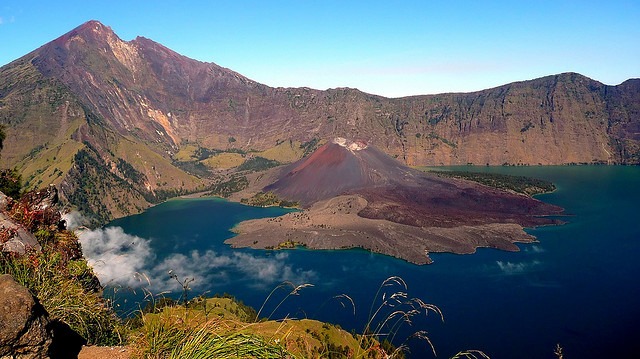A Brief History of the Formation of Mount Rinjani
Mount Rinjani is one of the highest volcanoes in Indonesia, standing at 3,726 meters above sea level. Located on Lombok Island, West Nusa Tenggara, it is part of the Mount Rinjani National Park. Besides being a favorite destination for hikers, Rinjani holds a long and fascinating geological history. The Formation Process of Mount Rinjani Mount Rinjani was formed through a series of volcanic activities that occurred millions of years ago. Geologically, it is part of the Sunda-Banda volcanic arc, which was created due to the subduction of the Indo-Australian Plate beneath the Eurasian Plate. This activity triggered the emergence of volcanoes along the arc, including Rinjani. It is estimated that this mountain was once taller than it is today. However, a massive eruption around the year 1257 AD caused much of its peak to collapse, forming the large caldera that now contains Segara Anak Lake. This eruption is even believed to have contributed to global climate change due to volcanic ash spreading into the atmosphere. Eruptions and Volcanic Activity Mount Rinjani is an active volcano that has experienced several major eruptions throughout history. One of the most significant was the eruption in 1257, which is considered one of the largest volcanic eruptions in human history. Its impact was not only felt around Lombok but also caused climatic changes in various parts of the world. Inside Rinjani’s caldera lies Mount Barujari, a smaller active volcano. Mount Barujari remains active today and frequently experiences small to moderate eruptions. Beauty and Cultural Significance Beyond its geological significance, Mount Rinjani holds deep cultural value for local communities. The Sasak people and Balinese Hindus consider the mountain a sacred place. Every year, they conduct rituals and ceremonies around Segara Anak Lake as a form of respect for nature and their ancestors. With its stunning natural beauty, intriguing volcanic history, and strong cultural significance, Mount Rinjani continues to attract researchers, hikers, and tourists from around the world.
Adi
3/8/20251 min read


A Brief History of the Formation of Mount Rinjani
Mount Rinjani is one of the highest volcanoes in Indonesia, standing at 3,726 meters above sea level. Located on Lombok Island, West Nusa Tenggara, it is part of the Mount Rinjani National Park. Besides being a favorite destination for hikers, Rinjani holds a long and fascinating geological history.
The Formation Process of Mount Rinjani
Mount Rinjani was formed through a series of volcanic activities that occurred millions of years ago. Geologically, it is part of the Sunda-Banda volcanic arc, which was created due to the subduction of the Indo-Australian Plate beneath the Eurasian Plate. This activity triggered the emergence of volcanoes along the arc, including Rinjani.
It is estimated that this mountain was once taller than it is today. However, a massive eruption around the year 1257 AD caused much of its peak to collapse, forming the large caldera that now contains Segara Anak Lake. This eruption is even believed to have contributed to global climate change due to volcanic ash spreading into the atmosphere.
Eruptions and Volcanic Activity
Mount Rinjani is an active volcano that has experienced several major eruptions throughout history. One of the most significant was the eruption in 1257, which is considered one of the largest volcanic eruptions in human history. Its impact was not only felt around Lombok but also caused climatic changes in various parts of the world.
Inside Rinjani’s caldera lies Mount Barujari, a smaller active volcano. Mount Barujari remains active today and frequently experiences small to moderate eruptions.
Beauty and Cultural Significance
Beyond its geological significance, Mount Rinjani holds deep cultural value for local communities. The Sasak people and Balinese Hindus consider the mountain a sacred place. Every year, they conduct rituals and ceremonies around Segara Anak Lake as a form of respect for nature and their ancestors.
With its stunning natural beauty, intriguing volcanic history, and strong cultural significance, Mount Rinjani continues to attract researchers, hikers, and tourists from around the world.
Social Media
Visit Our Social Media
© 2024. All rights reserved.
